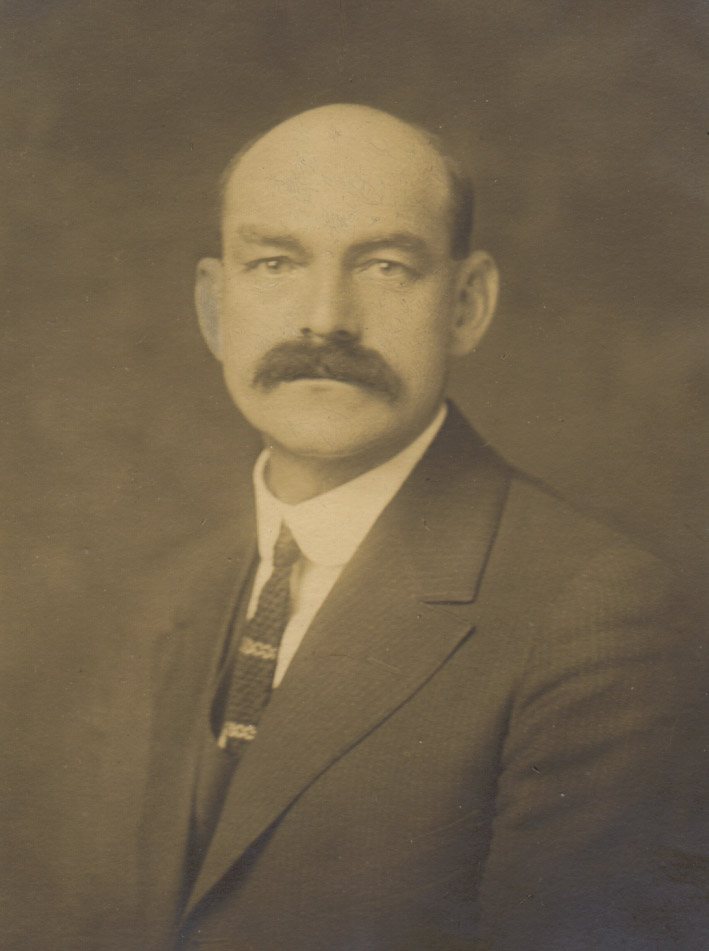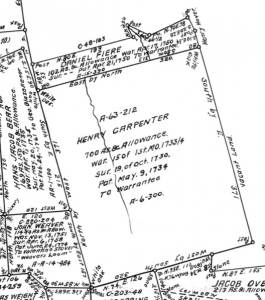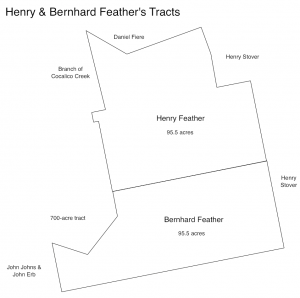I received an email a while back from a woman who was looking for information on a Jacob Hoover of Maryland and wondered if we were related. The short answer is “Yes,” but not as initially thought.
She had found my site by searching for “Jacob Hoover Maryland.” I believe, she found my information on the family of Andreas Hoover (1723—1784) of Frederick (now Washington) County, Maryland and Fayette County, Pennsylvania and Andrew’s son Jacob (ca 1746—1800). She was searching for the father of Jacob Hoover of Garrett County, Maryland. She had information going back from a John Hoover (1860—1929) to his parents Jacob and Mary (Bittinger) Hoover. She had no dates for Jacob and Mary, but believed Jacob’s father was also named Jacob. Looking at information online, she had found two possibilities, both sons of two Andrew Hoovers.
From my research, I knew that Andrew Hoover’s (1723—1784) son Jacob had only one son—George Hoover who moved from Fayette County, Pennsylvania to Ohio County, Kentucky. George did have a son named Jacob, but he lived in Kentucky, dieing there sometime between 1840 and 1850. Based on this information, I knew that her Jacob Hoover [Sr.] was not a son of Andrew Hoover, nor a grandson through his son Jacob. It was possible that he was the son of one of Andrew’s other sons, but if so, I had no information on him.
The other possibility was Andrew Hoover (1724—ca 1794) of Frederick (now Carroll) County, Maryland and Randolph County, North Carolina. He, too, had a son named Jacob (1754—1821). However, I believe, he went to North Carolina with his family and died there in 1821.
Based on the birth dates of these Jacob Hoovers—1746 and 1754, respectively, I knew it was unlikely that either of them were the grandfather of John Hoover, born in 1860. If her Jacob, Jacob, and John were related to either of these men, then there was a missing generation. More information was needed on both Jacob Sr. and Jacob Jr. before their ancestry could be determined.
Curious, I started looking at John Hoover in the census records, starting with the most recent and working backwards:
-
1920: John married to [Anna] Savora and living in Grantsville, children: Della E. (b. ca 1904), Zelda M. (b. ca 1907), Orval (b. ca 1910), Dora V. (b. ca Mar 1915), Claton E.(b. ca Jul 1918)
- 1910: John (2nd marriage) married for 7 years (ca. 1903) to Annie S. (1st marriage) and living in Grantsville, children: Della E. (b. ca 1903), Zelda (b. ca 1906), Orval (b. ca Feb 1910), Burly (b. ca 1895)
- 1900: John, born April 1860, living in Grantsville, widowed, children: Clara (b. Mar 1891), Burly (b. Nov 1894), Harry (b. Feb 1897) and Allie E. (b. Jun 1899)
- 1880: John, born ca 1860, living in Grantsville at home with parents Jacob & Mary Hoover, siblings: Jefferson (b. ca 1849), Lydia (b. ca 1851), Ellen (b. ca 1855), Mary (b. ca 1862), Daniel (b. ca 1866), Elizabeth (b. ca 1869), Jacob (b. ca 1872), Sarah (b. ca 1875)
- 1870: John, born ca 1860, living in Grantsville at home with parents Jacob & Mary Hoover, siblings: Jefferson (b. ca 1850), Lydia (b. ca 1853), Ellen (b. ca 1855), Mary (b. ca 1863), Daniel (b. ca 1866), and Elizabeth (b. ca 1869)
- 1860: John is not listed, instead Jacob Jr. & Mary Hoover’s household includes: Jefferson (b. ca 1846), Lydia (b. ca 1848), Ellen (b. ca 1858), and Daniel (b. ca Jan 1860); It’s possible that this “Daniel” is actually John
The 1860 census lists Jacob Hoover as Jacob Jr. Junior can often be interpreted to mean that the father shared the same given name. However, it can sometimes mean “the younger” with no familial relationship attached.
However, an examination of Maryland deeds through MDLandRec.net showed that Jacob Hoover Sr. and his wife Mary sold 25 acres in Allegany County to their son Jacob Hoover Jr. Jacob Hoover Jr. sold this land to his wife Mary in 1874. Both deeds refer to lots 2138 and 2139. Additionally, Jacob Hoover and wife sold 25 acres of their property “Shylock War” to Jacob Hoover Jr. in 1862. Other pieces of this property were sold to Carlisle and William Hoover, their other sons., This establishes, to my mind, that Jacob Hoover Jr. was most likely the son of Jacob Hoover Sr. and his wife Mary “Polly.”
Jacob and Mary Hoover Sr. were alive and living in the third district (Grantsville) in 1860 and 1870. Their son William (b. ca 1834-1837) was living with them in both census enumerations. Both enumerations also list Jacob and Mary as being born in Pennsylvania. In 1850, they’re living in district 10 with their daughter Sarah.
Based on these census records, Jacob Hoover Sr. was born about 1790-1797 in Pennsylvania. Given the location of Grantsville, Allegany and Garrett counties, it’s likely that Jacob came from Bedford, Somerset, Fulton or Adams counties in Pennsylvania. There were several Jacob Hoovers in the Casper Hoover family of Somerset County, Pennsylvania, so I contacted another researcher who knows much more about this family than I do on the off chance that this Jacob was possibly related.
He wrote back:
“The Jacob Hoover who married Mary “Polly” Eckenberger was the son of George and Elizabeth (_____) Hoover of Somerset County, PA. George Hoover was the son of Casper and Catherine (Ernst) Hoover of Somerset County, PA, as described in my NGSQ article (vol. 91 (December 2003), pgs. 298-313). Jacob Hoover was born in Somerset County on or about 25 March 1797 and moved to Garrett County, MD, around the year 1820 with his wife Mary “Polly” (Eckenberger) Hoover. They remained in Garrett County the rest of their lives. This family is reasonably well described in Wayne Bittinger’s book “The Bittinger, Bittner, Biddinger, and Bidinger Families and their Kin of Garrett County, Maryland” (McClain Printing Co., Parsons, WV, 1986, pgs 609-611). Some information is also given in the same book regarding Jacob “Ecenbarger/Akenberger”, Jr., the brother of Mary “Polly” Ekenberger Hoover (pgs. 551-553).”
So, yes, we are related through Jacob Hoover Sr.’s grandfather Casper, brother to my presumed ancestor, George Hoover of Lancaster, Bedford, Westmoreland and Armstrong counties.




